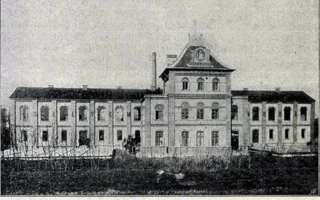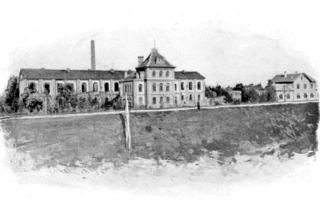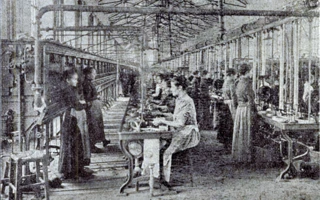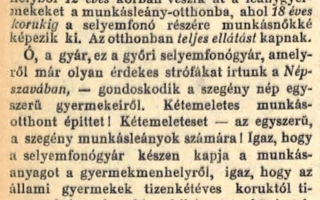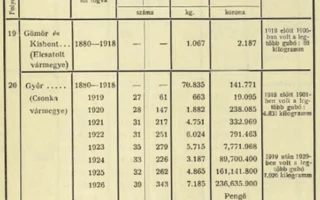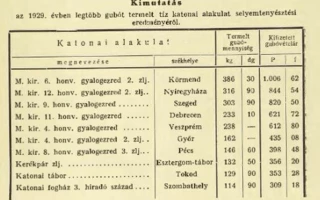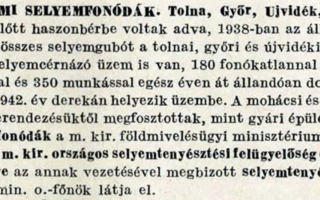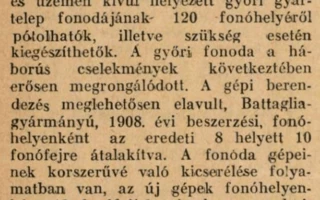Contact details
Foundation for Industrial History of Győr
Szent István út 10/a
Phone:
+3696520274
Fax: +3696520291
E-mail:
ipartortenet@ipartortenet.hu
Map
Hungarian Silk Spinning Mills Győr Factory Site
| Address of the memorial site, route planning | ||
| What can we see at the memorial site? | ||
| Brief overview | ||
| Detailed company history | ||
| Interesting facts | ||
| Literature, references | ||
| Related gallery |
| MEMORIAL SITE ADDRESS, ROUTE PLANNING |
| WHAT CAN WE SEE AT THE MEMORIAL SITE? |
Street view:
A picture from the past:

Source: Description of the silk spinning and reeling industry of Hungarian sericulture. 1880-1910. In. Magyar Kelmefestő Újság, 1912.09.22. No. 38. p. 325.
| BRIEF OVERVIEW |
|
Hungarian silk farming was supervised by the state, so the silk industry established for the processing of silk was also a state monopoly. Thanks to the boom in silk cocoon farming in the second half of the 1800s, new factories were built one after another in the territory of historical Hungary. Due to the excellent quality of Hungarian silk, it was in demand on the international market, and foreign companies lined up to rent the silk factories established with state investment. The Győr silk mill, officially known as the Győr Gyártelepe of Hungarian Silk Spinning Factories, was built in 1900. The French tenants were Dumas & Martin from Lasalle. The silk cocoon warehouse already stood on the Rába bank, where the cocoons brought from the exchange stations were stored after various treatments until use. This justified the construction of the silk spinning mill in Újváros, near the warehouse. The workforce was provided by training the daughters of state orphanages, who lived in workers' quarters. A modern girls' home was built for the working women in 1911. During World War I, the military took possession of the building, and then the factory resumed production between the two world wars. In June 1938, the factory stopped operating because the state did not extend the contract with the tenant, the Royal Silk Mills Lease Co., Ltd., and 300 jobs were lost. From August 1939, the silk spinning factory resumed production with 130 workers. The state took over the previously leased silk spinning mills in 1938, and their direct management was provided by the Royal Hungarian Royal National Silk-Cultivation Inspectorate. In 1941, the Győr factory operated with 120 boilers and 350 workers. During World War II, when production ceased, Polish officers were held in the spinning mill building. After they were evacuated, the building was hit by a bomb. In 1945, the soldiers of the Soviet expeditionary unit rebuilding the Rába railway bridge stayed here, and then from 1946 to 1952 the oil factory used it as a warehouse, as the Economic Council decided in 1947 not to rebuild or put into operation the Győr factory, because the capacity of the Tolna spinning mill proved sufficient to process the country's projected annual cocoon production. The building was given to the Győr Car Tool Machine Factory on 1 January 1953, which was later transformed several times. On 1 April 1976, it was renamed the Hungarian Wagon and Machine Factory Special Machine Factory. After the change of regime, the Rába Special Machine Factory was purchased by Hörmann and Bárdi Autó.
The Silk Spinning Mill in the second half of the 1910s Source: Borovszky Samu: Counties and Cities of Hungary, Győr County. 1908. p. 138. |
||
| DETAILED COMPANY HISTORY |
For a more detailed summary of the Győr Factory of the Hungarian Silk Spinning Mills, see the Győr Salon website under the title : The Győr Silk Spinning Mill and the Spinning Workers' Quarters , author: Szilvia Antaliné Hujter
| ÉRDEKESSÉGEK |
|
Interior view of the Győr silk mill Source: Description of the silk spinning and reeling industry of Hungarian sericulture. 1880-1910. In. Magyar Kelmefestő Újság, 1912.09.29. 39. issue. 333. page. https://adtplus.arcanum.hu/hu/view/BME_MagyarKelmefestoUjsag_1912/?query=gy%C5%91ri%20selyemfonoda&pg=326&layout=s
In issue 4 of Népszava, published on July 23, 1908, M. Kir. wrote about the poor working conditions experienced at the Győr Silk Spinning Factory.
Assessment of the workers' accommodation to be built from the workers' perspective. Népszava, April 4, 1911, p. 10.
Invitation to tender for the construction of a silk mill workers' accommodatio
Agricultural Bulletin, 1912, October 27, No. 44, p. 1370.
Csonkamagyarország, December 11, 1927, No. 50, p. 4.
Győr County sericulture data between 1880-1929
István Fent: From the 250-year history of Hungarian sericulture. Page 229. Source: https://edok.gyorikonyvtar.hu/book/-/record/kkmk571894;jsessionid=34759051E2D8ED4BAFF6213DE39B386D
The military also took part in silk cocoon production, and parachutes were made from silk.
István Fent: From the 250-year history of Hungarian sericulture. Page 249. Source: https://edok.gyorikonyvtar.hu/book/-/record/kkmk571894;jsessionid=34759051E2D8ED4BAFF6213DE39B386D
On the operation of the Győr branch of the Royal Silk Mills in 1942
Industrial joint-stock companies. In. Great Hungarian Compass 66/2. (1942)
Magyar Textiltechnika reports on the state of the Győr silk mill in 1947.
Hungarian Textile Technology, 1 Dec. 1947, No. 2, p. 58. |
||
| LITERATURE |
- István Fent: From the 250-year history of Hungarian sericulture. Budapest, National Sericulture Inspectorate of the Royal Ministry of Agriculture, 1930. 255 pages.
- József Árpád Papp: A short history of the Győr Silk Spinning Factory and the Orfelináta Girls' Home. In. Collection of studies of the Local History Club of the Rába Cultural Center. Győr, 1979. pp. 89-108.
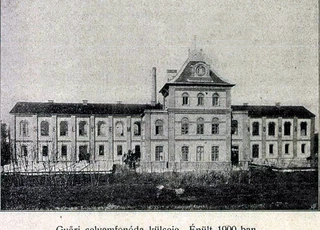
Related gallery
Back to the previous page!












